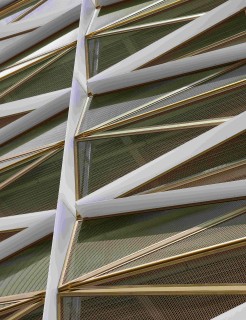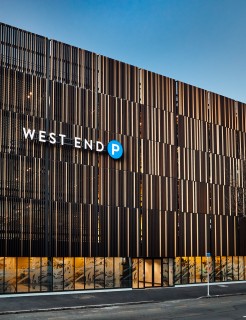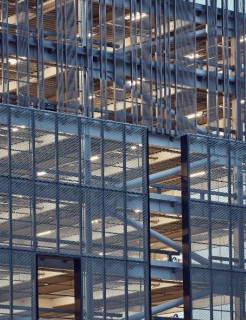
Investigating Vortex Shedding at Outlook Apartments
The Situation
Outlook Apartments is a 4 storey complex in a prime Auckland location. Finished to the highest standards, as is evident from the exterior which shimmers in a veil of golden louvres and aluminium tubing, the residences were targeted to discerning individuals who would appreciate the visual elegance of the design, along with the privacy and sun-shading of the facade.
However, the design called for a screen of vertical 38mm diameter tubes to wrap the corners of the building. The arrangement of the tubes raised suspicions about possible vortex shedding and the subsequent vibrations, which had the potential to turn the tubes into a giant musical instrument that would most assuredly not be appreciated by the occupants. This can happen when alternating vortices are formed at a specific frequency, resulting in an aeolian tone or whistle. Additionally, as sound is an energy made by vibrations, any sound would likely result in structural vibration (although not always) and this can lead to the rapid degradation or failure of facade elements.
With a considerably high threat of wind noise and/or vortex induced oscillation, and anticipated cost of any mitigation to follow, the decision was made to wind test the facade elements.
Testing Methodology
The first step was to undertake computer analysis of airflows to confirm whether to proceed with physical testing or not. This analysis showed there was significant potential for noise and the only way to comprehensively rule this out would be to conduct testing using a 1:1 scale mock-up.
We proceeded with physical testing using such a mock-up and the wind tunnel. It involved gradually increased wind speeds, with the mock-up rotated to varying angles. This progressed until wind speeds were reached which would be considered highly abnormal for the location.
Testing Results & Recommendations
Testing showed that even at high speeds, the vortex induced oscillation experienced was to such a low level that there was no danger of wind-induced noise and excess vibrations, therefore no danger of occupants being exposed to unwanted sounds and fatigue induced failure of the tubes and structural elements.
Conclusion
Given the proven lack of noise, the project could continue as originally planned with the architectural intent being realised in full.
This is the perfect result and one of the reasons wind tunnel testing is a pragmatic step on specific projects. It’s not about discovering faults and wind-related issues as much as it’s about making sure the architectural vision can come to fruition without the risk of future issues. Finding out there will be no need for change, and no need for costly mitigation should problems be uncovered after the building is commissioned, is the desired outcome.


Related Articles:
Wind Induced Noise in Building Facades
The Danger of Wind: Physical & Financial









